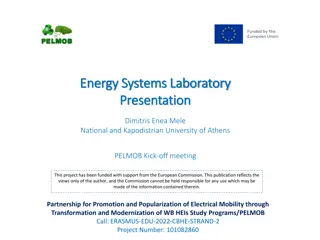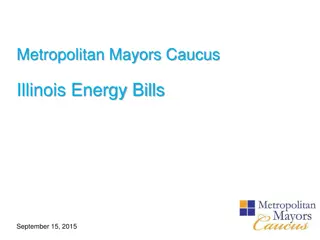Developing a Microgrid Model for Enhanced Energy Resiliency
This project focuses on creating a comprehensive model of a microgrid with photovoltaic and battery storage systems to enhance energy resiliency. It emphasizes the importance of renewable energy-based solutions for reliable power supplies, cost-effective operations, and improved system stability. The team aims to address power outage challenges by simulating microgrid performance and operational strategies while ensuring system resilience and functionality.
Download Presentation

Please find below an Image/Link to download the presentation.
The content on the website is provided AS IS for your information and personal use only. It may not be sold, licensed, or shared on other websites without obtaining consent from the author.If you encounter any issues during the download, it is possible that the publisher has removed the file from their server.
You are allowed to download the files provided on this website for personal or commercial use, subject to the condition that they are used lawfully. All files are the property of their respective owners.
The content on the website is provided AS IS for your information and personal use only. It may not be sold, licensed, or shared on other websites without obtaining consent from the author.
E N D
Presentation Transcript
Advisor: Mahsood Shahverdi Team Lead: Christian Flores Photovoltaic System Energy Storage System Droop Control Operations Christian Flores Christian Flores Devyn Cordero Felix Abel Felix Abel Felix Abel Derek Castaneda Christian Flores Carlos Rodenzo Jonathan Monroy
Agenda 1. Introduction/Background 2. Statement of Work 3. Emergency Diesel Generator Derek Castaneda Christian Flores Devyn Cordero/ Carlos Rodezno /Jonathan Monroy/ Derek Castaneda Christian Flores Felix Abel Felix Abel Felix Abel 4. Component Modeling 5. Sizing Microgrid 6. Microgrid Operation Cost 7. Summary
Introduction WHAT IS A MICROGRID? A local energy grid with control capability EVERYONE is affected when repairing a traditional grid WHY RENEWABLE-ENERGY-BASED OPTIONS? We need to maximize the penetration of renewable-energy-based generations Provides reliable power supplies and fuel diversification Enhances energy security Helps conserve natural resources
Problem RESILIENCY Power outages are now an accepted practice In 2019, SoCal Edison cut the power to about 200,000 customers The resiliency of a system is defined as its ability to return to a stable operation point after a major disruption event Microgrids are considered as a potential solution to deal with major power disruption events
Agenda 1. Introduction/Background 2. Statement of Work 3. Emergency Diesel Generator Derek Castaneda Christian Flores Devyn Cordero/ Carlos Rodezno /Jonathan Monroy/ Derek Castaneda Christian Flores Felix Abel Felix Abel Felix Abel 4. Component Modeling 5. Sizing Microgrid 6. Microgrid Operation Cost 7. Summary
Objective Create a model of a microgrid. Includes Photovoltaic plus a battery storage system. Manage the cost of operation. Develop an operation scheme. Maintain functional operation to supply power to load.
Requirements Functional Requirements: 1. Frequency stability of the microgrid system 2. Shall provide cost effective operational strategy 3. Shall provide simulation of microgrid system Performance Requirements: 1. Maintain 60Hz within +- 5% using Linear Droop Control by finding failure points with different loads 2. Develop daily costs of operational strategy and maintenance 3. Microgrid system must be resilient for 4 hours
Agenda 1. Introduction/Background 2. Statement of Work 3. Emergency Diesel Generator Derek Castaneda Christian Flores Devyn Cordero/ Carlos Rodezno /Jonathan Monroy/ Derek Castaneda Christian Flores Felix Abel Felix Abel Felix Abel 4. Component Modeling 5. Sizing Microgrid 6. Microgrid Operation Cost 7. Summary
Emergency Diesel Generator Simulation of Emergency diesel Generator in islanded mode To determine the limitations of the microgrid system
Power to Current A 1-D Lookup table was used that contained an excel sheet with GHI information that was converted to Real Power. The real power simulates the inclusion of a Photo-voltaic solar panel.
Disconnection from Grid Circuit Breaker is open to simulate "islanded mode" 1000MVA/10kV used to emulate power grid Includes a 25kV/2400v step-down transformer
Load Demand A 1-D lookup table was used containing 24 hours' worth of real power data The data was acquired from National Renewable Energy Laboratory (NREL) It was decided to put a gain of 10,000 to make the net load equal to the nominal power of the diesel generator
Excitation Block Block models an AC Alternator driving a diode rectifier to produce the field voltage required by the SM We chose AC1A Excitation block because its voltage regulator gave a voltage in p.u. with a lower limit of zero
Diesel Engine Governor Controls fuel to engine cylinders in order to control the speed of the unit Speed is held constant for all loads imposed on the generator being driven by the engine The first input (wref) is the reference speed and the second input (w) is the measured speed Output is the diesel engine mechanical power
Synchronous Machine AC motor, at steady-state, the rotation of the shaft is synchronized with the frequency of the supply current. It is often used where precise constant speed is required Can operate at leading or unity power factor Provides power factor correction
Dynamic load scope-24 Hours This is the graphical representation of the PQ load information mentioned earlier. We are considering a 100% power factor for simulation purposes which is why the blue line (Q signal) is zero
Dynamic load scope-10 hours When running the simulation, it was advised that we set the stop time to 10 seconds so the simulation can simulate efficiently. The graph represented to the right is the data we used from the PQ signal for our simulation which represents 10 hours.
Synchronous Machine Speed Wm is the machine speed of the Synchronous Machine When the diesel generator kicks in the speed of the synchronous machine should be as close to 1 as possible in order to keep it in unity factor
Synchronous Machine Mechanical Power This graph shows the mechanical power at the machines shaft The mechanical power is the speed times the torque
Synchronous Machine Field Voltage Vf represents the field voltage This voltage is supplied by a voltage regulator as an input This value is usually constant
Synchronous Machine Terminal Voltage Vt graph represents the terminal voltage of the system The terminal voltage is 0 when there is no load in the circuit This measures the potential difference between the terminals
Negative current subsystem This subsystem was created because the Dynamic load has a negative current (arrow facing down) To make our current a negative current we decided to connect the positive side to ground and the negative to the system
Why is this important? Allows for operational costs to be analyzed Operational strategy limitations can be studied and improved upon Provides frequency stability for the microgrid system
Agenda 1. Introduction/Background 2. Statement of Work 3. Emergency Diesel Generator Derek Castaneda Christian Flores Devyn Cordero/ Carlos Rodezno /Jonathan Monroy/ Derek Castaneda Christian Flores Felix Abel Felix Abel Felix Abel 4. Component Modeling 5. Sizing Microgrid 6. Microgrid Operation Cost 7. Summary
Photovoltaic Model Average hourly power profile for a day Model is sized with battery to provide 200kWh to load Peak power output during midday Photovoltaic model outputs average hourly solar energy generation
Battery Model Excess Energy The equation relates current to battery state of charge Charge/Discharge current profile Simulink battery model Limit Battery efficiency of 80%
Battery Degradation Model Depth-of-Discharge can be calculated from State-of-Charge data DOD inverse of SOC Capacity fade data used for battery modeling Charging cycles of battery contribute to capacity fade Cost of battery degradation
Agenda 1. Introduction/Background 2. Statement of Work 3. Emergency Diesel Generator Derek Castaneda Christian Flores Devyn Cordero/ Carlos Rodezno /Jonathan Monroy/ Derek Castaneda Christian Flores Felix Abel Felix Abel Felix Abel 4. Component Modeling 5. Sizing Microgrid 6. Microgrid Operation Cost 7. Summary
Sizing Of Battery Model We Sized the Battery using the System Advisor Model (SAM) software. Based on the Demand Data that we have from a Commerical building ,the recommended sizing that we used is shown below: Battery Bank Size (kW) Battery Bank Power Size (kW) Desired size (kWdc) 200 100 200
Agenda 1. Introduction/Background 2. Statement of Work 3. Emergency Diesel Generator Derek Castaneda Christian Flores Devyn Cordero/ Carlos Rodezno /Jonathan Monroy/ Derek Castaneda Christian Flores Felix Abel Felix Abel Felix Abel 4. Component Modeling 5. Sizing Microgrid 6. Microgrid Operation Cost 7. Summary
Flowchart Flowchart for forMicrogrid Microgrid Operation Operation Scheme Scheme
Microgrid Operation Cost Fixed Operation Cost Variable Operation Cost Replacement Battery Cost Power Sold to Grid Total Operation Cost $257.58 $119,917.54 $24244.513 -$2148.40 $142272.23 The Table above shows the Operation Cost of the Microgrid for an entire day
Agenda 1. Introduction/Background 2. Statement of Work 3. Emergency Diesel Generator Derek Castaneda Christian Flores Devyn Cordero/ Carlos Rodezno /Jonathan Monroy/ Derek Castaneda Christian Flores Felix Abel Felix Abel Felix Abel 4. Component Modeling 5. Sizing Microgrid 6. Microgrid Operation Cost 7. Summary
Summary Our Microgrid's PV and Battery was sized to meet the demand of the System. Microgrid Operation Scheme is dependent on both time and state of charge of our battery. Our Microgrid is dependent on a Battery ,a PV array to charge our battery and is grid connected to meet the demand when the PV and Battery do not meet the demand of the system. In order to test how the microgrid will react when put into islanded mode, an emergency diesel generator and governor were used to see how quick the grid's frequency will stabilize when disconnected.























